Since 1990, the world's first TV leap forward has been launched. The cathode cathode ray tube (CRT) TV, which has been accompanying us for more than half a century, has been replaced by a smaller liquid crystal display (LCD). It has become the protagonist in the living room. However, the goal of scientists to pursue the color quality and thickness reduction of TV screens has not stopped. After several years of development, the "Organic Light EmitTIng Diode" (OLED) and "Quantum Dot" (Quantum Dot) , QD) TV is becoming more and more mature, and the possibility that the rising star will gradually replace the LCD TV is getting higher and higher. Let's take a look at the difference between these two future new displays.
The three primary colors of light
Before understanding the display principle, let's first understand how color is achieved in various display technologies. They are all in red (R, R), green (Green), and blue (Blue). "Different brightness" can be combined into almost all visible light colors in a continuous spectrum, so we call red, green, and blue colors "the three primary colors of light." As shown in Figure 1, suppose there is a square to display a certain color. Such a square is called "pixel". The square is cut vertically into three small squares, representing RGB 3 kinds. Color, such a small square is called "Sub-pixel".
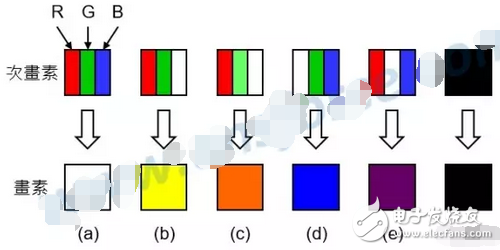
â–² Figure 1: Red, green, and blue colors can be combined into almost all colors in the continuous spectrum with different brightness.
Color display
Visible light has an infinite variety of colors. Figure 2 shows the ChromaTIcity diagram, which represents all the colors that the naked eye can see. The wavelength of light is the color, how many wavelengths of light there are, and how many colors there are. The red, green and blue colors are just a general visual experience. The light generated by different light-emitting components has some differences in wavelength. Therefore, the colors produced by different light-emitting components are different and different. The traditional LCD TV (LCD-TV) with white LED (WLED) as the backlight is called "LED-TV". Note that although the manufacturer calls it LED-TV, it is actually "backlit with LED". The source LCD-TV" uses the "Color filter" to generate RGB 3 colors of light. The triangle vertices in the figure are RGB 3 colors, and the color inside the triangle is what the TV can do. All the colors of the composition (the larger the triangle, the more colors can be combined, the more realistic the color), obviously can not be combined into all the colors that the naked eye can see, but this is enough to make a TV let us see the real image; Later, some manufacturers developed different colors of RGB generated by different white light-emitting diodes (LEDs) and color filters, which can be combined into more colors (red triangles), called "wide color gamut LED-TV", but these two All kinds of TVs use color filters to filter white light to produce RGB 3 colors, and currently the white light-emitting diodes (LEDs) used in industrial backlights are limited in color, so the colors that can be combined are still Not enough; it can be seen that the RGB 3 colors produced by the organic light-emitting diode television (OLED-TV) can be combined into more colors (green triangles); and the RGB three colors produced by the quantum dots (QD-TV) Can be combined into more colors (blue triangles).
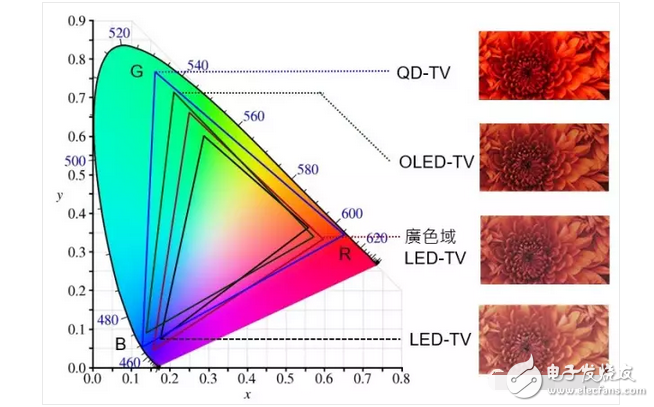
â–² Figure: ChromaTIcity diagram.
Organic light emitting diode
Organic Light Emitting Diode (OLED), also known as "Organic Electrical Luminescence" (OEL), is shown in Figure 3. It is an "organic light-emitting semiconductor" that emits red, green, and blue light. The organic molecules that emit light are heated and evaporated on the conductive glass, and then the metal electrodes are vapor-deposited, and voltages are injected into the organic light-emitting semiconductors of different colors to inject electrons and holes, and the electrons and the holes are combined to emit light in the organic light-emitting semiconductor. Its structure is simple, the brightness is high enough, but the organic light-emitting semiconductor is actually an "organic molecule" (similar to plastic). Due to the unstable nature of the light-emitting material, the yield is low during production, the cost can not be reduced, and the use It has a short life span and will fade after a long time, so it has been used in small amounts on monochrome displays. After more than a decade of hard work, South Korea's Samsung and LG have successfully improved the yield. Now they have already produced more than 60 彩色 color TVs, leaving only the problem of over-priced. It seems that it has slowly seen its commercial value.
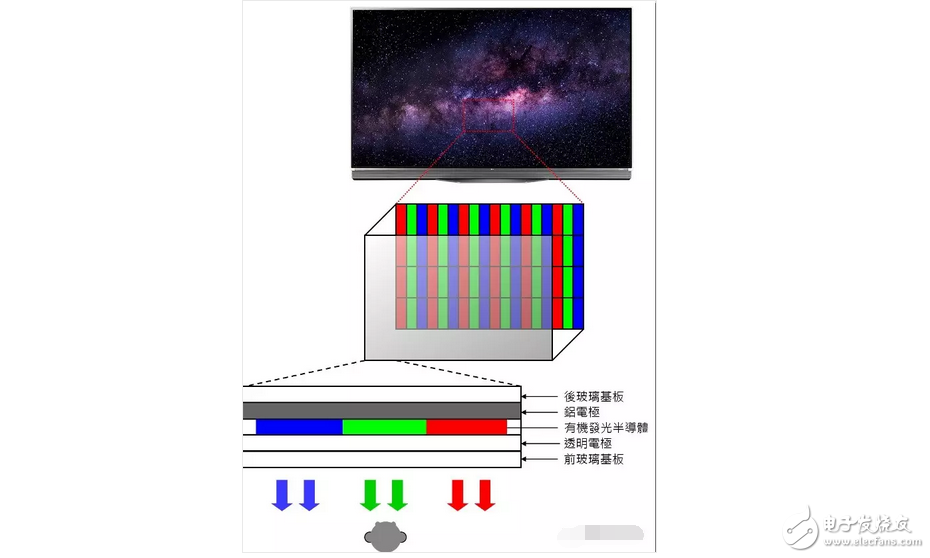
â–² Figure 3: Organic Light Emitting Diode (OLED) construction. (Source: LG)
Quantum Dot TV (QD-TV)
Scientists have discovered that when the size of a material is as small as 100 nanometers or less, a "quantum confinement effect" occurs, in which electrons and holes are confined within the nanomaterial to form a self-organized stable state, causing a change in luminescent properties. Moreover, the smaller the size of the nanomaterial, the stronger the luminous intensity of the material, and the shorter the wavelength of the luminescence (blue). This phenomenon is called "blue shift". As shown in Fig. 4, the wavelengths of light of different colors are different. Therefore, the wavelength of light is the color, the wavelength of red light is the longest in visible light, the second is green light, and the blue light is the shortest. In other words, when the size of nanomaterial is large, the intensity of light is weak, and the color is red (the longest wavelength) When the size of the nano material becomes smaller, the luminescence intensity becomes stronger, the color is green light (the wavelength is second); when the size of the nano material is smaller, the luminescence intensity is stronger, and the color is blue light (the wavelength is the shortest).
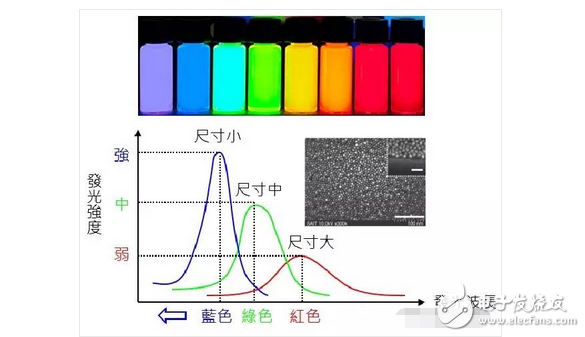
▲ Figure 4: The “blue shift†of quantum confinement effects. (Source: Tae-Ho Kim et al., Heterogeneous stacking of nanodot monolayers by dry pick-and-place transfer and its applicaTIons in quantum dot light-emitting diodes, Nature Communications, Article number: 2637, Published 06 November 2013)
The principle of traditional white light-emitting diode (WLED) illumination is that blue light-emitting diode (BLED) crystals emit blue light to illuminate YAG phosphor, and the phosphor absorbs blue light to produce white light, as shown in Figure 5(a). The RGB color of the components is limited, and the colors that can be combined are still not enough. Therefore, we can directly use the quantum dot (QD) instead of the phosphor called “quantum dot light-emitting diode (QD-LED)â€, as shown in Figure 5(b). As shown, the use of such a component for the backlight of a liquid crystal display (LCD) can increase the RGB color, as shown in Figure 5(c), so the color that can be combined is greatly increased, and there is no need to modify too many liquid crystal displays (LCD). The construction is the lowest cost, but color filters must still be used.
If you want to add RGB color, you can use blue light-emitting diode (BLED) as the backlight, as shown in Figure 5 (d), through the LCD panel, and print the quantum dots directly on the panel to form different times. The pixel replaces the color filter and is illuminated by the blue backlight module. The red quantum dot absorbs blue light and emits red light. The green quantum dot absorbs blue light and emits green light. The blue quantum dot absorbs blue light and emits blue light. Because the color of the pixel is the same as that of the backlight module, the blue quantum dot can be omitted. The structure of the final quantum dot television (QD-TV) is shown in Fig. 6.
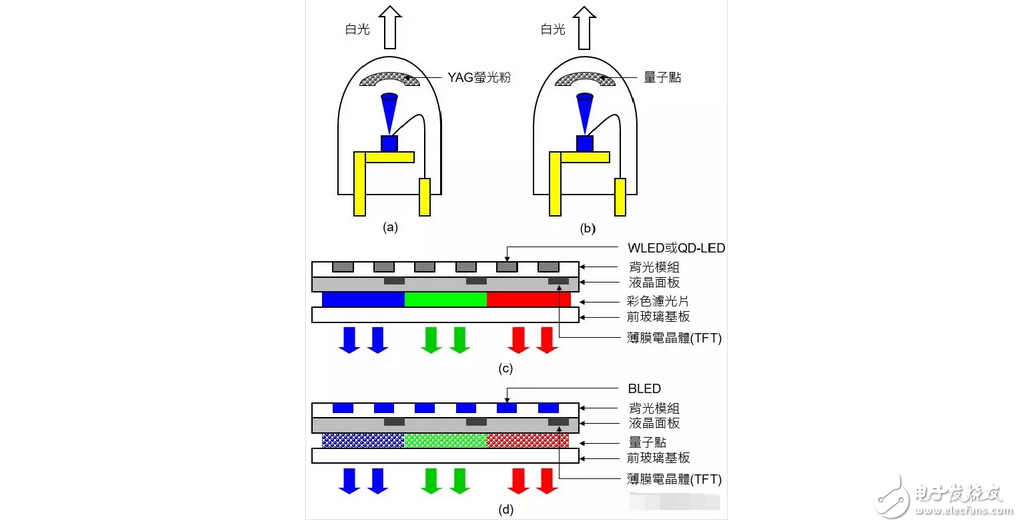
â–² Figure 5: Schematic diagram of white light-emitting diodes and quantum dot light-emitting diode (QD-LED) TVs.
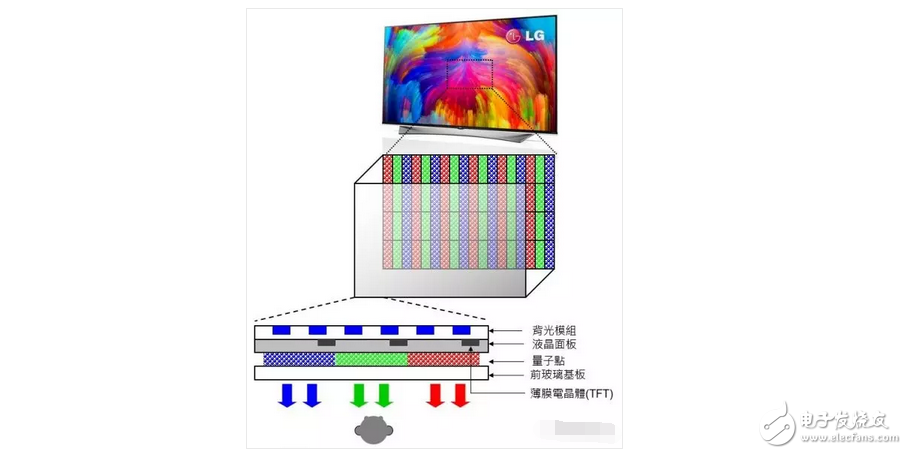
â–² Figure 6: Schematic diagram of the construction of quantum dot television (QD-TV).
in conclusion
The traditional LCD TV (LCD-TV) market with white light-emitting diode (WLED) as the backlight has matured, and there is not much room for improvement in technology; although RGB is produced by organic light-emitting diode television (OLED-TV) Colors can be combined into more colors, but lower yields result in higher prices, and it seems that they cannot be fully promoted in a short period of time; and RGB 3 colors produced by QD-TV can be combined into the most Color, and does not need to modify too much liquid crystal display (LCD) structure, is indeed one of the currently feasible methods, but remember, in fact, quantum dot TV is also a liquid crystal TV, it still depends on the liquid crystal image, so it It is still a kind of LCD TV. The term “quantum dot†in marketing, which sounds full of “technical colorâ€, is mostly an advertising marketing technique. In the foreseeable future, the TVs in our homes will become thinner and thinner, and the colors of the pictures will become more and more abundant, allowing us to see pictures that are as real as nature on TV.
Guangzhou Fengjiu New Energy Technology Co.,Ltd , https://www.flashfishbatteries.com